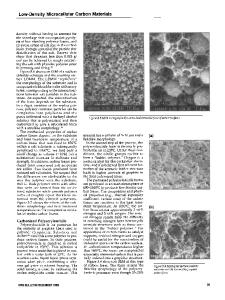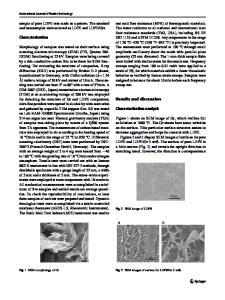Preparation and Properties of Low Density Replica Carbon Foams
- PDF / 1,993,565 Bytes
- 5 Pages / 420.48 x 639 pts Page_size
- 26 Downloads / 380 Views
PREPARATION AND PROPERTIES OF LOW DENSITY REPLICA CARBON FOAMS* S. S. HULSEY AND P. K. POCO. Chemistry & Materials Science Department, Lawrence Livermore National Laboratory, Livermore, CA 94550
ABSTRACT Low density foams are used for a variety of applications, including catalytic supports, battery anodes, microporous membranes, and laser fusion targets. The technique for making replica carbon foams described in this paper has been previously reported[I] and involves a process in which an inorganic substrate (sodium chloride) is infused with a carbonizable polymer. After carbonization, the substrate is removed by a leaching process and the wet foam is dried; the resultant foam is referred to as replica carbon. This paper describes improvements in the processing which result in a smaller pore size and improved foam homogeneity. The original substrate is the single most important factor affecting the resultant structure. Techniques to improve the uniformity of the substrate and the translation of substrate anomalies into the final product are described. INTRODUCTION Low density foams have important applications such as catalytic supports, microporous membranes, and laser fusion targets. Carbon foams are of particular interest in these applications because of their small cell sizes which nominally range from 1-25 microns, their excellent machinability, and their dimensional stability. The technique used for making carbon foams is a replication process in which an inorganic substrate (in this case, sodium chloride) is infused with a carbonizable polymer. After carbonization, the salt substrate is removed by leaching and the wet foam is dried. Foams prepared in this manner are referred to as replica carbon. We have long suspected and have since demonstrated that the cell size of these foams is largely determined by the size of the salt used to prepare the sacrificial substrates. A variety of techniques was used to change the salt size to attempt to reduce the ultimate cell size in the foam. A good correlation between the starting particle size of the substrate salt and the cell size is demonstrated. In addition, this paper evaluates several techniques to improve the homogeneity of the resulting foam. EXPERIMENTAL METHODS Replica carbon foam is made by pressing -400 mesh* sodium chloride into a sacrificial porous substrate, which is sintered at 6500C to improve its strength and durability during subsequent processing. The salt substrate is infused with a concentrated polymer solution (phenol-formaldehyde synthetic resin dissolved in acetone) which is allowed to wick into the substrate for 24 hours. The concentration of this polymer solution is varied between 20-35% by weight in order to achieve the desired density in the final foam (20-60 mg/cc.) The parts are removed from the resin and convection oven dried at 450 C to remove the acetone, leaving a thin polymer coating on the salt particles. The polymer/salt composite is then cured at 6000 C in an inert atmosphere to produce an amorphous carbon coating. The sodium chlo
Data Loading...











